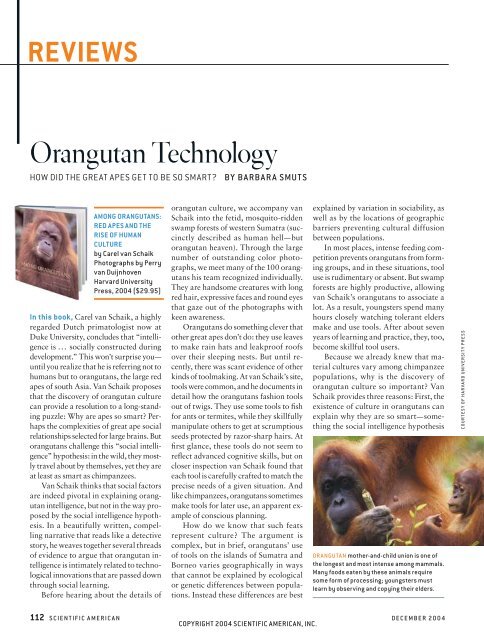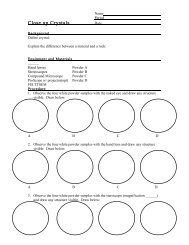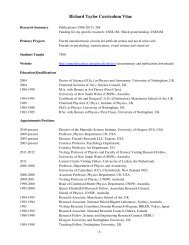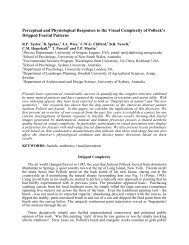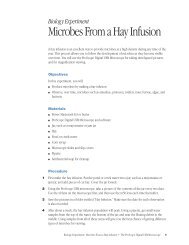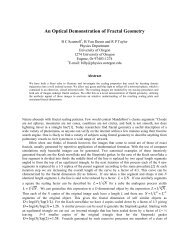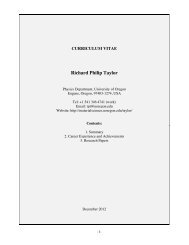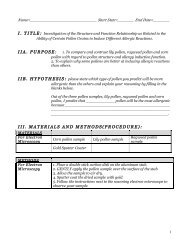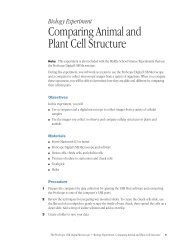December 2004 - Materials Science Institute - University of Oregon
December 2004 - Materials Science Institute - University of Oregon
December 2004 - Materials Science Institute - University of Oregon
Create successful ePaper yourself
Turn your PDF publications into a flip-book with our unique Google optimized e-Paper software.
REVIEWS<br />
Orangutan Technology<br />
HOW DID THE GREAT APES GET TO BE SO SMART? BY BARBARA SMUTS<br />
AMONG ORANGUTANS:<br />
RED APES AND THE<br />
RISE OF HUMAN<br />
CULTURE<br />
by Carel van Schaik<br />
Photographs by Perry<br />
van Duijnhoven<br />
Harvard <strong>University</strong><br />
Press, <strong>2004</strong> ($29.95)<br />
In this book, Carel van Schaik, a highly<br />
regarded Dutch primatologist now at<br />
Duke <strong>University</strong>, concludes that “intelligence<br />
is ... socially constructed during<br />
development.” This won’t surprise you—<br />
until you realize that he is referring not to<br />
humans but to orangutans, the large red<br />
apes <strong>of</strong> south Asia. Van Schaik proposes<br />
that the discovery <strong>of</strong> orangutan culture<br />
can provide a resolution to a long-standing<br />
puzzle: Why are apes so smart? Perhaps<br />
the complexities <strong>of</strong> great ape social<br />
relationships selected for large brains. But<br />
orangutans challenge this “social intelligence”<br />
hypothesis: in the wild, they mostly<br />
travel about by themselves, yet they are<br />
at least as smart as chimpanzees.<br />
Van Schaik thinks that social factors<br />
are indeed pivotal in explaining orangutan<br />
intelligence, but not in the way proposed<br />
by the social intelligence hypothesis.<br />
In a beautifully written, compelling<br />
narrative that reads like a detective<br />
story, he weaves together several threads<br />
<strong>of</strong> evidence to argue that orangutan intelligence<br />
is intimately related to technological<br />
innovations that are passed down<br />
through social learning.<br />
Before hearing about the details <strong>of</strong><br />
orangutan culture, we accompany van<br />
Schaik into the fetid, mosquito-ridden<br />
swamp forests <strong>of</strong> western Sumatra (succinctly<br />
described as human hell—but<br />
orangutan heaven). Through the large<br />
number <strong>of</strong> outstanding color photographs,<br />
we meet many <strong>of</strong> the 100 orangutans<br />
his team recognized individually.<br />
They are handsome creatures with long<br />
red hair, expressive faces and round eyes<br />
that gaze out <strong>of</strong> the photographs with<br />
keen awareness.<br />
Orangutans do something clever that<br />
other great apes don’t do: they use leaves<br />
to make rain hats and leakpro<strong>of</strong> ro<strong>of</strong>s<br />
over their sleeping nests. But until recently,<br />
there was scant evidence <strong>of</strong> other<br />
kinds <strong>of</strong> toolmaking. At van Schaik’s site,<br />
tools were common, and he documents in<br />
detail how the orangutans fashion tools<br />
out <strong>of</strong> twigs. They use some tools to fi sh<br />
for ants or termites, while they skillfully<br />
manipulate others to get at scrumptious<br />
seeds protected by razor-sharp hairs. At<br />
fi rst glance, these tools do not seem to<br />
refl ect advanced cognitive skills, but on<br />
closer inspection van Schaik found that<br />
each tool is carefully crafted to match the<br />
precise needs <strong>of</strong> a given situation. And<br />
like chimpanzees, orangutans sometimes<br />
make tools for later use, an apparent example<br />
<strong>of</strong> conscious planning.<br />
How do we know that such feats<br />
represent culture? The argument is<br />
complex, but in brief, orangutans’ use<br />
<strong>of</strong> tools on the islands <strong>of</strong> Sumatra and<br />
Borneo varies geographically in ways<br />
that cannot be explained by ecological<br />
or genetic differences between populations.<br />
Instead these differences are best<br />
explained by variation in sociability, as<br />
well as by the locations <strong>of</strong> geographic<br />
barriers preventing cultural diffusion<br />
between populations.<br />
In most places, intense feeding competition<br />
prevents orangutans from forming<br />
groups, and in these situations, tool<br />
use is rudimentary or absent. But swamp<br />
forests are highly productive, allowing<br />
van Schaik’s orangutans to associate a<br />
lot. As a result, youngsters spend many<br />
hours closely watching tolerant elders<br />
make and use tools. After about seven<br />
years <strong>of</strong> learning and practice, they, too,<br />
become skillful tool users.<br />
Because we already knew that material<br />
cultures vary among chimpanzee<br />
populations, why is the discovery <strong>of</strong><br />
orangutan culture so important? Van<br />
Schaik provides three reasons: First, the<br />
existence <strong>of</strong> culture in orangutans can<br />
explain why they are so smart—something<br />
the social intelligence hypothesis<br />
ORANGUTAN mother-and-child union is one <strong>of</strong><br />
the longest and most intense among mammals.<br />
Many foods eaten by these animals require<br />
some form <strong>of</strong> processing; youngsters must<br />
learn by observing and copying their elders.<br />
112 SCIENTIFIC AMERICAN DECEMBER <strong>2004</strong><br />
COPYRIGHT <strong>2004</strong> SCIENTIFIC AMERICAN, INC.<br />
COURTESY OF HARVARD UNIVERSITY PRESS


